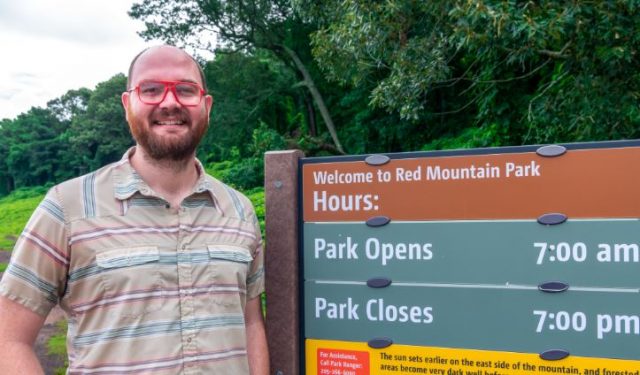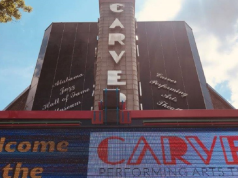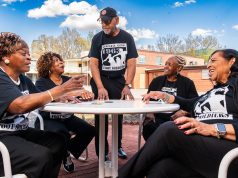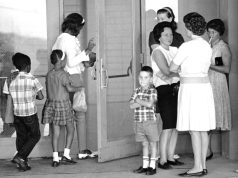By Ryan Michaels
The Birmingham Times
It was love at first hike.
Red Mountain Park (RMP) Executive Director Thomas Carl McLemore, who prefers “T.C.,” fell in love with the park in 2013, shortly after returning to Alabama following a trip to the Pacific Crest Trail (PCT), where hiked about 1,000 miles on the PCT.
“I’d come to Birmingham to finish grad school and gotten into trail running and hiking a lot. … It just so happened that RMP opened, I think, the week I left for [the PCT],” said McLemore. “So, I come back to Birmingham having this giant new park, and I started coming here all the time. It is a place where I found sanity and clarity. I’d come here and think through things like, ‘How am I going to write my master’s thesis?”
The PCT runs the length of the western U.S., starting at the U.S.-Canada border and going through the states of Washington, Oregon, and California, all the way to the U.S.-Mexico border.
McLemore, 32, remembers hiking on that trail, starting from the Mexican border, where a “generous” couple dropped him and a group of three friends off.
“We started walking north,” he said. “You cover about 20 to 30 miles a day, and about every five days, you happen upon a town you can hike into. A lot of times, the PCT is a little removed from town, so we would hitchhike into a town.”
After making it into a town, McLemore and his friends would find a roof to sleep under and grab some grub before heading back out onto the trail.
“Motel 6 was our favorite. It’d be me and three other guys in a one-room in a Motel 6—smelled terrible,” McLemore said. “We’d all get cleaned up, order a giant pizza each, go grocery shopping to re-up [on supplies], maybe spend one day not hiking, hitchhike back out to the trail, and go again.”
After following that same routine for two months, McLemore headed back home to Alabama, where he was finishing up his master’s degree in history at the University of Alabama at Birmingham (UAB). Upon returning, McLemore found RMP, which, he said, “was at the intersection of a lot of things I cared about.”
In fact, RMP influenced his master’s thesis. While investigating the intersection of food and race in Birmingham, McLemore studied the residents of U.S. Steel Corp. towns, such as Wenonah, through the work of people like Birmingham native Horace Huntley, a noted historian who holds a Ph.D. in African American and labor history, has served as director of oral history work for the Birmingham Civil Rights Institute, and is a former UAB professor that helped create the school’s African American studies curriculum.
“I listened to oral histories of miners who lived in this town for my master’s thesis. I also read a lot of public health surveys of these company towns and spent a lot of time reading historians like Huntley and Marlene Rikard, a Samford University professor, who captured those experiences of company town life and the experiences of workers here on the mountain,” McLemore said.
RMP is located on a 1,500-acre former mining complex completely within the city limits of Birmingham. It is mostly within the Oxmoor neighborhood but also spills into Tarpley City, West Goldwire, Garden Highlands, and Mason City.
Another appealing aspect of both the park and Birmingham is the ease with which citizens can access its natural sites, McLemore said: “When you fly into Denver, [Colorado], you have to drive an hour to the Front Range to go hiking. When you fly into Birmingham, you’re basically flying in right next to Ruffner [Mountain], and Red Mountain is just 20 minutes from the airport.”
“Liked the Outdoors”
McLemore grew up in Fort Payne, Alabama. While he “liked the outdoors,” he had not fully been acquainted with the idea of hiking.
“I grew up hunting and fishing with my dad, as well as working outside with my granddad. … Still, I didn’t really know that hiking and backpacking were recreational options,” he said. “That wasn’t something I grew up around.”
Just after McLemore graduated from Fort Payne High School, he and his family took a trip to the Grand Canyon, which “blew his mind.” During his freshman year at UAB, McLemore saw an opportunity to revisit the Canyon and immediately went back.
“They hosted a 10-day-long backpacking trip to the Grand Canyon, so I signed up. My first overnight backpacking experience was in the Grand Canyon, thanks to UAB,” McLemore said. “From there, [hiking’s] just the thing I wanted to do.”
Hiking is a debated term, though. When McLemore says “hiking,” he often means “just walking.”
“There are rhetorical barriers between hikers and people who might not perceive themselves as hikers,” he said. “You do not have to call yourself a hiker to come to RMP. … I want more people to see themselves enjoying what RMP offers without having to first identify as a hiker, biker, trail runner, or anything like that.”
Joining the Park
Given McLemore’s attraction to Red Mountain, he joined the RMP junior board in 2015 and later became president in 2018. Prior to his work with the park, McLemore had also served in various roles for Alabama Possible, an organization that seeks to reduce poverty; the Alabama Humanities Alliance, a group that encourages creativity and stives to get people engaged in storytelling, lifelong learning, and civic purpose; and the Alabama chapter for the National Endowment for the Humanities, which funds various arts endeavors.
The same year McLemore became RMP junior board president, he was told to apply for the executive director position. It made him realize that he could connect his nonprofit experience with his interests in history and the outdoors, McLemore said.
“I thought, ‘Oh, I could do all of these things at once, and I think I have a point of view that will be effective here,’” he said.
With the current direction of the park, McLemore is inspired by Ervin Batain, the son of a miner in the Grasselli Heights neighborhood, who became the first person to use the area now known as RMP. In 1999, Batain cleared a path from the backyard of his house into the abandoned Mine No. 11, one of the 15 mines that operated on the mountain.
During his trips to the mine, where he would often take family, friends, and other locals, Batain collected numerous artifacts. He also started 3D at No. 11 Mining Camp and Nature Trail, an official nonprofit museum named for his three sons: Demetrius, Deon, and Devon.
Batain was doing both the outreach and the interpretive work—the term academics use to refer to “interpreting” the artifacts and geography of a particular space to place it into historical context, McLemore said.
Executing the Vision
Community leaders had interesting ideas for the space long before the official establishment of RMP in 2012. Huntley, who is from Birmingham’s Riley-Travellick neighborhood, developed some ideas about how to use the abandoned mines on the mountain as a public space. And Gregory Wilson, a history instructor at Lawson State Community College who grew up in Bessemer, Alabama, has devoted time to amassing oral histories through interviews with people in and around the former mining area.
“[Batain and Huntley] were using it and dreaming about it in dynamic ways before 2000,” McLemore said.
Though it’s clear that though Batain and Huntley led those early ideas for the park, the people in the surrounding communities also felt ownership of the space. Batain’s ideas were visible through his 3D at No. 11 Mining Camp Museum, as well as the many tours he conducted on the mountain. As for Huntley, he simply had ideas of it being some sort of massive complex.
As it stands today, RMP consists of 15 miles of trails, along which there are picnic areas, overlooks, treehouses, zip lines, a six-acre dog park, and several old mines to observe.
McLemore is dedicated to the vision of those early members of the community, like Batain.
“[Batain] served on [the RMP board] until he died in 2014, but his work wasn’t really incorporated into the plans by previous park administrators, as far as I understand it,” McLemore said, adding that his goal is the same as Batain’s—just with a generation in between.
“I think I feel now the way [Batain] must have felt in 2000 or in the 1990s, when he was capturing the oral histories of miners, like those in his dad’s generation,” McLemore said. “Now, I feel compelled to capture the story of the people that captured the stories. I think it consumed his life, and I get it because it’s kind of consuming mine.”





